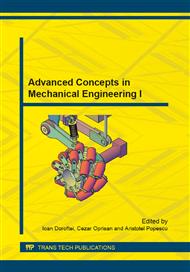p.177
p.183
p.189
p.195
p.201
p.207
p.213
p.219
p.225
Influence of Several Parameters on Simulating the Ballistic Impact on a Homogenous Plate
Abstract:
This paper presents a simulation of a bullet impact on a plate made of a homogeneous and isotropic material. The developed model takes into account the yield and fracture limits of both involved materials for the bullet and the plate one. The model was developed with the help of Ansys 14.0 and could be used to establish a theoretical value of the plate thickness that will offer protection to the bullet penetration in order to minimize the number of laboratory tests for evaluating the plate resistance. The authors presented the influence of impact velocity of the bullet. The bullet velocity just reaching the plate is an essential parameter influencing the plate integrity. Also, the authors established a correlation between the evolution of the theoretical maximum von Mises stresses and the stages taking place during the impact.
Info:
Periodical:
Pages:
201-206
Citation:
Online since:
October 2014
Authors:
Keywords:
Price:
Сopyright:
© 2014 Trans Tech Publications Ltd. All Rights Reserved
Share:
Citation:


